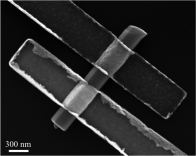NanoMemristive System
Memristive nanodevices are predicted to introduce new revolutionizing paradigms in in computing and electronics.
They are typically simple metal/insulator/metal structures based on resistive switching, i.e. a reversible conductance change due to a reorganization of the matter on a nanometric scale. From one side, when employed as the so-called Resistive Random Access Memories (RRAMs or ReRAMs), they are envisioned among the most promising alternatives in data storage, thanks to their very high switching speed, high integration density and low power consumption. On the other hand, the possibility of finely controlling their resistance value in an analog fashion make them a nearly perfect candidate for brain-inspired computing technologies and artificial intelligence.
In such a scenario, our current research is focusing on:
- resistive switching in nanostructured materials such as ZnO nanowires
- neuromorphic behavior of memristive devices based on ALD oxides
- nanoscale characterization of resistive switching mechanisms
Please have a deeper look clicking on the following links:



